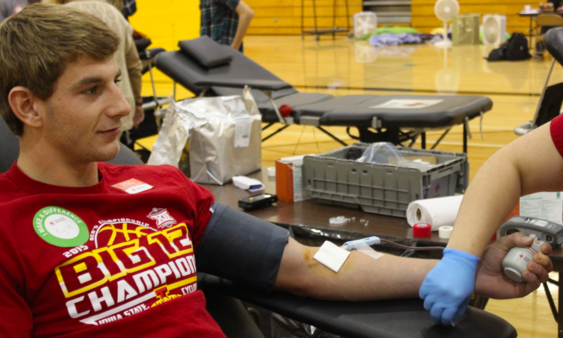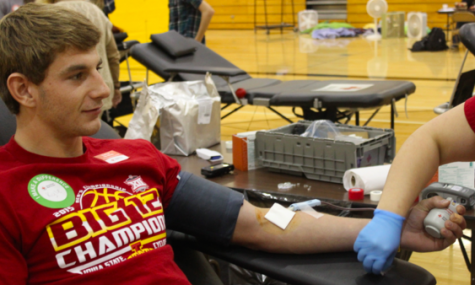NHS Blood Drive Exceeds Last Spring’s Donations

Senior Kyle Nelson donates blood.
November 16, 2015
AHS NHS Sponsors Blood Drive
On Wednesday, Oct. 28, National Honor Society (NHS) sponsored the annual fall blood drive. Students who signed up donated blood to the American Red Cross, and were then rewarded with snacks and drinks.
Eighty-six people showed up, but six were turned away for being underweight (minimum 120), four people who reached the chairs to give blood refused at the last minute and two people didn’t show up at all, leaving the tally at 72. This number, though, was 10 more than last spring, which means 30 more lives saved (3 lives per donation). NHS Supervisor Marcus Upchurch said, “I thought it was really good. We had a good turnout by the NHS members and a good turnout from new donors. We actually ended an hour later than we were supposed to.”
The new goal for next spring is 80 units based on the great participation this time, and it’s always hard getting more people to sign up and donate. People are weary about donating, but Upchurch said it’s always nice knowing you helped save a life. Bailey Schildberg, a first time blood-giver, said, “If you have a good first experience, I feel like you’re willing to give more. Plus, it’s always nice to get the nice, free food you eat after you donate.”
The Process of Donating Blood
In the process of donating blood, preparation is important. According to the Red Cross website, the first step to prepare is to always make sure you are drinking enough water and are properly hydrated. Donors also need to make sure they have an iron-heavy diet in the week(s) before their blood drive to have enough iron in their blood to be able to donate.
The person will also need a list of medications they are taking and an ID. It is advised by the American Red Cross to bring a friend along to help you through if you are nervous and to always remember to relax and don’t think about it too much. After the preparation, you are ready to donate.
When someone walks into a blood drive, they must first register and go over simple donation information. This is where they’ll need the form of ID. The next step is to go through medical history and a mini physical to see if they are well enough to give blood. The nurses check their pulse, temperature, blood pressure, and hemoglobin levels found in a sample of blood. If they are confirmed to give blood and all of their levels are okay, it is now their turn to actually donate blood.
The nurse they are assigned to will clean up their arm and then proceed to stick a new, sterile needle in their arm about where the forearm and upper arm connect. Once the nurses find their vein and blood starts pumping out, they are sat comfortably for 8-10 minutes until about a pint of blood has been collected. After this, they are bandaged up and informed to go eat a snack and get something to drink.
What Happens to the Blood From There?
After someone gives blood, they know a patient in need will receive it, but don’t know the exact process and route of the blood. At the end of the day, the Red Cross collects all of the donated blood and it goes into the processing phase.
In this phase the blood is “scanned into a computer database” and then most is spun in “centrifuges” to separate the plasma, red cells, and platelets. The components from there are sent to different areas. The plasma, for example, can be manufactured farther into elements like “cryoprecipitate.” The red cells and platelets are “leukoreduced” and then put in test tubes to be tested.
The test tubes are sent out to “one of three Red Cross National Testing Laboratories.” On each unit of donated blood a dozen tests are completed to determine the blood type and confirm it is infectious disease-free. If a blood sample is tested positive it is disposed of and the donor is notified. Within 24 hours the information is collected and and transferred to the manufacturing facility. This information is confidential to everyone but the donor and the government upon request.
After the results are received, the units that passed are labeled and stored. Red Cells are stored for 42 days at 6 °C (42.8 °C) before it is distributed to different hospitals. The platelets are held in “agitators” at room temperature for up to five days. Finally, the plasma and cryoprecipitates are frozen for up to one year before being distributed.
Have any questions?
Go to www.redcross.org or NHS supervisor Marcus Upchurch for more information.













